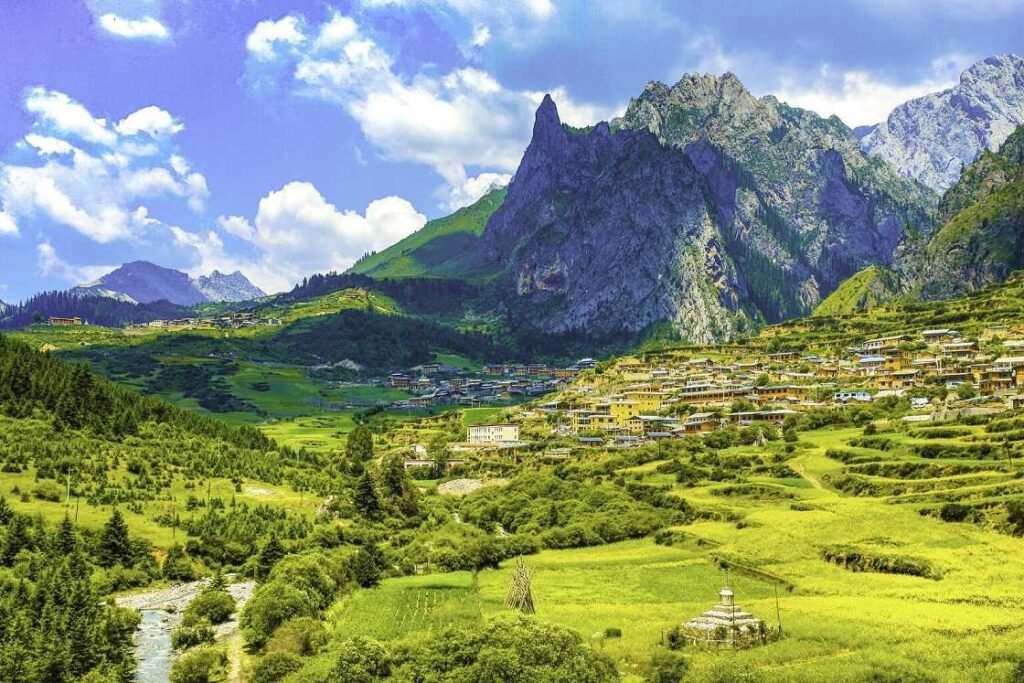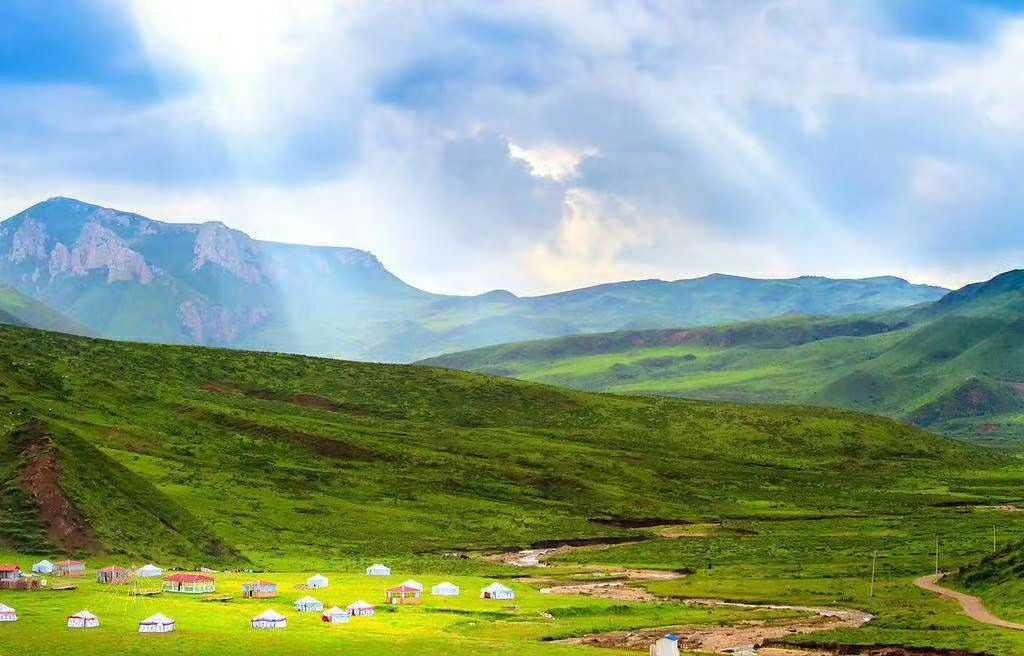1. Why choose Zaga Na Horseback Riding Adventure?
Zagana is located in Gannan Tibetan Autonomous Prefecture, Gansu Province, China. In Tibetan, it means “stone box.” It consists of four Tibetan villages: Dongwa Village, Yeri Village, Daji Village, and Daba Village, at an altitude of 3,000-3,300 meters. American explorer Rock called it “the Garden of Eden on Earth.” Its core appeal lies in:
- Geological Wonders: Granite peaks, glacial gorges, and alpine meadows intertwine to form a natural “stone palace.”
- Cultural Uniqueness: A 700-year-old Tibetan village preserves traditional stilt-house architecture, with villagers still leading a semi-agricultural, semi-nomadic lifestyle.
- Horseback Riding Advantages: Horseback riding is the best way to explore Zaga Na—traversing inaccessible secret landscapes and experiencing the nomadic spirit of the Amdo Tibetan region.

2. Naheika Pasture: A Cloud-Sweeping Journey on Horseback
Naheika (Tibetan for “God of Wealth Ridge”) is Zaga Na’s summer pasture, located at an altitude of 3,900 meters, accessible only by horseback. Below is the latest 2025 experience guide:
- Route Highlights
- The Path of the Brave: Departing from Daji Village, ride along a cliffside horse trail for 8 kilometers, with the Zaga Na Grand Canyon plunging hundreds of meters below, its gray-white cliffs resembling a coiled dragon.
- Lado Lake Holy Water Ceremony: Collect water from the glacial lake behind the pasture. Tibetans believe the lake water brings good fortune, and the guide will teach you to recite blessings in Tibetan.
- Quaternary Glacial Remnants: Touch the glacial scratches on the rock walls and learn how tectonic movements 200 million years ago shaped this land.
- Practical Information
- Cost: Horseback riding costs 350 RMB per person (including insurance), lasting 3-4 hours, including Tibetan robe rental and a commemorative certificate.
- Safety Requirements: Weight limit of 90 kg, wear anti-slip hiking boots (no high heels), and children must use a double safety saddle.
- Best Time: June to September when the meadows are in full bloom, and October when autumn colors paint the snow-capped peaks.

3. Tibetan Village Cultural Immersion Experience
The villages of Zaga Na are living cultural museums. Recommended interactive activities include:
| Experience Program | Content | Location |
|---|---|---|
| Tibetan Home Visit | Learn to make butter tea, shape barley flour dumplings, and listen to elders recount the legend of “Cloud Village Daba” (cost: 50 RMB per person) | Yeri Village, Daba Village |
| Lasang Temple Blessing | Spin 108 prayer wheels at the Gelugpa-style ancient temple, and monks will bestow barley blessings (Note: Photography is prohibited inside the temple) | Dongwa Village Summit |
| Bonfire Pot Dance | Free participation every night at 8:00 PM in each village square, learn to dance the “sleeve-lifting step” dance, and drink barley wine to ward off the cold | Four Village Squares |
| Handmade Thangka | Paint auspicious eight treasures patterns with mineral pigments and take them home as souvenirs (120 yuan per piece, takes 1.5 hours) | Tibetan Culture Experience Center |
Cultural Taboos: Remove shoes before entering a house, do not touch Buddha statues with your fingers, and accept a khata by bowing your head and receiving it with both hands.
4. 2025 Itinerary Planning
▎Three-Day In-Depth Tour (Suitable for First-Time Visitors)
- Day 1: Acclimatization to High Altitude + Initial Exploration of Tibetan Villages
Morning: Private car from Lanzhou to Zaga Na (6 hours), check-in at Daji Village Yunju Hotel (floor-to-ceiling windows offering panoramic views of the stone city).
Afternoon: Light hike along the Fairy Beach (3-kilometer wooden boardwalk) to photograph the reflections of the Tibetan village and stone peaks.
Evening: Wait for sunset at the Rock Viewing Platform, where the stone peaks are bathed in golden light like a miracle. - Day 2: Horseback Riding Adventure at Naheika
Morning: Arrive at Daji Viewing Platform at 5:30 AM to photograph the morning mist and cloud waterfalls.
Morning: Horseback ride along the Warrior’s Path to Nahaika, participate in the sacred lake blessing ceremony.
Afternoon: Visit a Tibetan family to learn how to make tsampa, and join the bonfire party in the evening. - Day 3: Geological Exploration and Return Journey
Morning: Hike through the Runwu Gorge, crossing waterfalls and glacial stone gates.
Afternoon: Visit the Century-Old Tibetan House, a wooden structure, and purchase yak jerky (vacuum-packed, 35 yuan per pound) before returning.
▎Professional Player Recommendations
Challenge the 3-day Rock Road Crossing: Zaga Na → Guangai Mountain Pass (4,000 meters above sea level), requires a guide + camping gear, encounter rock sheep and green gentian along the way.
5. Safety and Practical Tips
- High-Altitude Adaptation
- Avoid showering on the first day, bring ibuprofen to relieve headaches, and rent an oxygen tank (20 yuan per tank).
- Day-night temperature difference of 15°C; even in summer, bring a lightweight down jacket.
- Transportation Guide
- Self-driving: Lanzhou → Zaga Na 460 kilometers. During the rainy season (July–August), some mountain roads are prone to landslides; an SUV is recommended.
- Chartered vehicle: 7-seat vehicle from Lanzhou 800 yuan/day; minivan from Diebu County to the scenic area 50 yuan/person.
- Tips to Avoid Pitfalls
- Choose a reputable horseback riding service (registered at the south gate of the scenic area) to avoid “fixed-price” scams.
- Admission is 80 yuan per person, including an eco-friendly shuttle bus; student IDs receive a 50% discount.
Traveler’s Notes:
As you gallop across the Naheka Pasture, yak herds scatter like black pearls across the green carpet; as you sit by the Tibetan family’s fire pit, the steam from butter tea blurs the snow-capped peaks outside the window—at this moment, Zaga Na is no longer just a landscape, but a thousand-year-old epic of the Amdo Tibetan people living in harmony with nature.
Bookmark our website, and we will provide you with more China travel guides

















